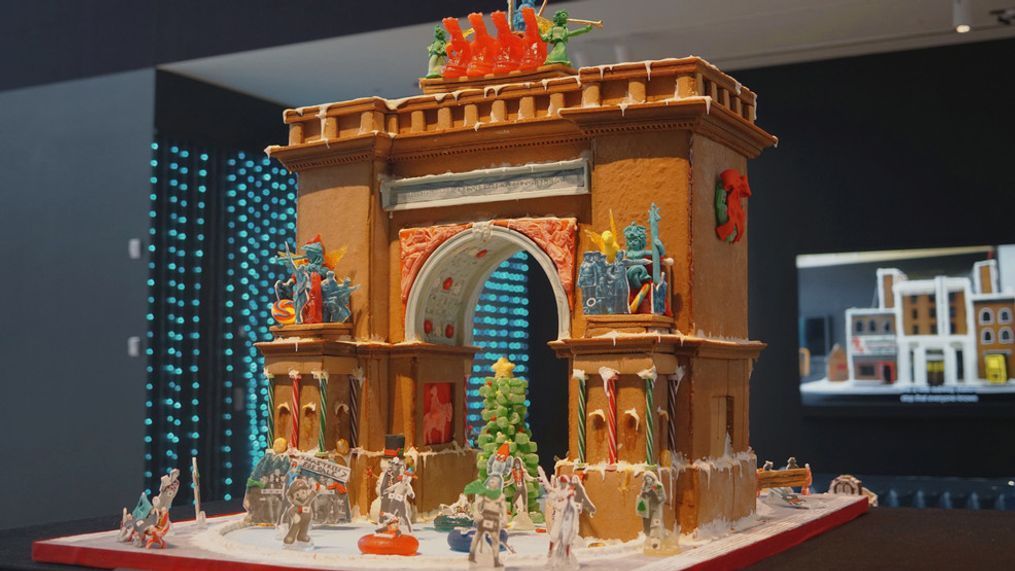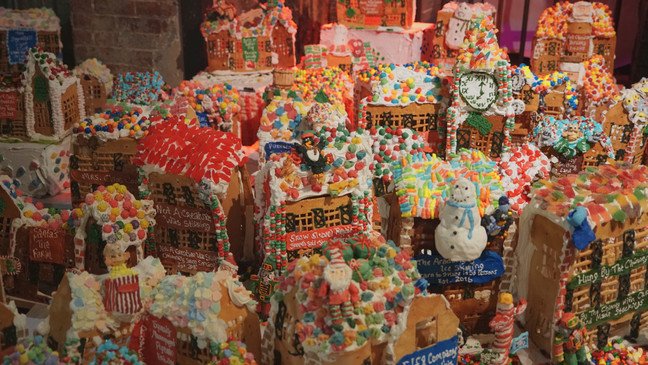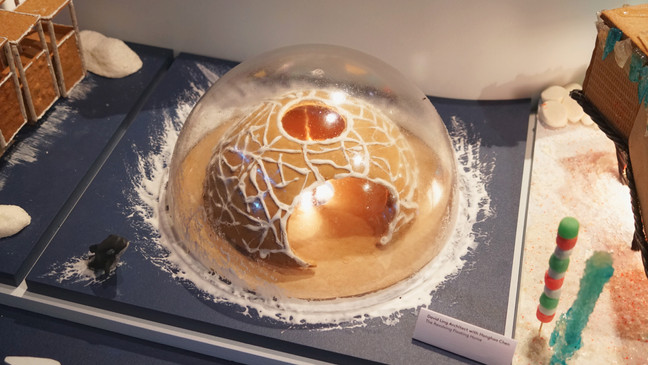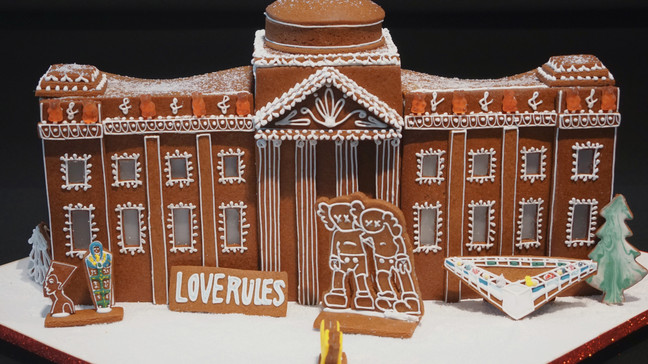Gingerbread cityscapes make the holiday season even sweeter in New York City
NEW YORK (TND) — Hansel and Gretel would have had better luck in New York City than in the woods.
There, the sweet-loving siblings might have followed their empty stomachs not to the appetizing facade of a witch’s candy-coated lair but onto the rink of an edible Rockefeller Center, glazed with icing and dotted with peppermints and gingerbread trees. If they still felt famished, the 80-foot-tall Norway spruce towering over the tableau, also made of gingerbread, surely would have satisfied their hunger for quite some time.
Later, as long as they fared better with a subway map than their trail of breadcrumbs, Hansel and Gretel may have wandered through an entire village of scrumptious structures, knocking as they pleased on hundreds of doors without any worry of witches. Under saccharine M&M rooftops, eateries serving roasted nuts and Thanksgiving dinner could balance out the excess of sugar consumed thus far. And when the two children felt ready to rest, they could have wandered past gummy octopuses into the airlock entrance of the Seashell Hotel, situated beneath the ocean in a futuristic gingerbread city where underwater development is crucial in coping with climate change.
It’s thanks to Hansel and Gretel — and the Brothers Grimm’s 19th-century telling of their suspenseful saga — that three separate gingerbread exhibits are filling New Yorkers’ appetite for holiday cheer this December. The tradition of elaborately decorated gingerbread cookies originated prior to the fairy tale, but it was the Grimms’ tantalizing description of the witch’s wily trap that drew bakers to the trend as swiftly as Hansel was tempted by the roof modeled out of cake.
... and when they came closer, they saw that the little house was built entirely from bread with a roof made of cake, and the windows were made of clear sugar.
{sd-embed class="sd-embedded-media" data-alt="IMG_2023122014190914.jpg" data-caption="Jon%20Lovitch,%20the%20creator%20of%20%22GingerBread%20Lane,%22%20first%20found%20his%20passion%20for%20gingerbread%20houses%20during%20a%201993%20competition.%20(Photo:%20Emily%20Faber,%20The%20National%20Desk)" data-duration="" data-externalid="e1ee1856-dbd1-4581-a8e0-f91b99663ab8" data-mediatype="image" data-renditions="%7B%22large16x9%22:%7B%22blurSigma%22:-1,%22height%22:2304,%22label%22:%22large16x9%22,%22scaleWidth%22:986,%22url%22:%22/resources/media/e1ee1856-dbd1-4581-a8e0-f91b99663ab8-large16x9_IMG_2023122014190914.jpg%22,%22width%22:4096,%22x%22:0,%22y%22:214,%22uuid%22:null,%22id%22:%2251b16e38-05b2-444d-825f-9014533b7f7a%22,%22preciseWidth%22:null,%22preciseHeight%22:null,%22name%22:%22large16x9Url%22,%22rendition%22:%22large16x9%22,%22labelOrConvertedName%22:%22large16x9%22%7D,%22jumbo16x9%22:%7B%22blurSigma%22:-1,%22height%22:2304,%22label%22:%22jumbo16x9%22,%22scaleWidth%22:1320,%22url%22:%22/resources/media/e1ee1856-dbd1-4581-a8e0-f91b99663ab8-jumbo16x9_IMG_2023122014190914.jpg%22,%22width%22:4096,%22x%22:0,%22y%22:214,%22uuid%22:null,%22id%22:%22131386b2-1d1f-4abd-920a-98ded6c7b389%22,%22preciseWidth%22:null,%22preciseHeight%22:null,%22name%22:%22jumbo16x9Url%22,%22rendition%22:%22jumbo16x9%22,%22labelOrConvertedName%22:%22jumbo16x9%22%7D,%22small16x9%22:%7B%22blurSigma%22:-1,%22height%22:2304,%22label%22:%22small16x9%22,%22scaleWidth%22:160,%22url%22:%22/resources/media/e1ee1856-dbd1-4581-a8e0-f91b99663ab8-small16x9_IMG_2023122014190914.jpg%22,%22width%22:4096,%22x%22:0,%22y%22:214,%22uuid%22:null,%22id%22:%229c4d8b80-d08c-472b-819a-1a265a6e4068%22,%22preciseWidth%22:null,%22preciseHeight%22:null,%22name%22:%22small16x9Url%22,%22rendition%22:%22small16x9%22,%22labelOrConvertedName%22:%22small16x9%22%7D,%22full16x9%22:%7B%22blurSigma%22:-1,%22height%22:2304,%22label%22:%22full16x9%22,%22scaleWidth%22:4096,%22url%22:%22/resources/media/e1ee1856-dbd1-4581-a8e0-f91b99663ab8-full16x9_IMG_2023122014190914.jpg%22,%22width%22:4096,%22x%22:0,%22y%22:214,%22uuid%22:null,%22id%22:%228db78499-0104-476d-b1bc-367183d0e589%22,%22preciseWidth%22:null,%22preciseHeight%22:null,%22name%22:%22full16x9Url%22,%22rendition%22:%22full16x9%22,%22labelOrConvertedName%22:%22full16x9%22%7D,%22medium16x9%22:%7B%22blurSigma%22:-1,%22height%22:2304,%22label%22:%22medium16x9%22,%22scaleWidth%22:648,%22url%22:%22/resources/media/e1ee1856-dbd1-4581-a8e0-f91b99663ab8-medium16x9_IMG_2023122014190914.jpg%22,%22width%22:4096,%22x%22:0,%22y%22:214,%22uuid%22:null,%22id%22:%22ef0d5987-d046-4db1-a765-f7f09e7c78fe%22,%22preciseWidth%22:null,%22preciseHeight%22:null,%22name%22:%22medium16x9Url%22,%22rendition%22:%22medium16x9%22,%22labelOrConvertedName%22:%22medium16x9%22%7D%7D" data-thumburl="/resources/media/e1ee1856-dbd1-4581-a8e0-f91b99663ab8-medium16x9_IMG_2023122014190914.jpg" data-title="Jon%20Lovitch's%20%22GingerBread%20Lane%22%20at%20Chelsea%20Market" data-url="" data-defaultthumb="true" data-embed-file="%0A%20%20%20%20%3Cdiv%20class=%22sda-ImageEmbed%22%3E%0A%20%20%20%20%20%20%20%20%3Cimg%20src=%22/resources/media/e1ee1856-dbd1-4581-a8e0-f91b99663ab8-medium16x9_IMG_2023122014190914.jpg%22%20alt=%22%22%20/%3E%0A%20%20%20%20%20%20%20%20%3Cdiv%20class=%22sda-ImageEmbed-caption%22%3EJon%20Lovitch,%20the%20creator%20of%20%22GingerBread%20Lane,%22%20first%20found%20his%20passion%20for%20gingerbread%20houses%20during%20a%201993%20competition.%20(Photo:%20Emily%20Faber,%20The%20National%20Desk)%3C/div%3E%0A%20%20%20%20%3C/div%3E" data-embed-type="image" contenteditable="false"}{/sd-embed}
There’s a also nod to Hansel and Gretel at “GingerBread Lane” in Manhattan’s Chelsea Market.
It’s hard to find the reference amid the colorful commotion of gingerbread and icing in the center of the food hall and retail marketplace’s main thoroughfare. Roofs topped with gummy bears and candy corn create a kaleidoscopic candy sea, all held together by enough globs of royal icing to create the impression of a recent blizzard. And once the magnitude of the installation has set in, the eyes will travel to so many toy soldier sculptures, snowman figurines, and tiny animals crafted out of, you guessed it, icing that locating one specific detail seems impossible.
But it’s there — Hansel and Gretel’s Hamburgers, with a sign advertising hamburgers, fries, and milkshakes, plus a giant hamburger sculpture affixed to the front of the building.
{sd-embed class="sd-embedded-media" data-alt="IMG_202312201419097.jpg" data-caption="The%20official%20Guinness%20World%20Records%20listing%20names%20Lovitch's%202017%20village%20as%20the%20largest%20ever,%20with%7B%7D1,251%20buildings%20on%20display%20at%7B%7Dthe%20New%20York%20Hall%20of%20Science%20in%20Queens.%20(Photo:%20Emily%20Faber,%20The%20National%20Desk)" data-duration="" data-externalid="e3454b45-b5de-4ae6-84cf-55656b6be749" data-mediatype="image" data-renditions="%7B%22large16x9%22:%7B%22blurSigma%22:-1,%22height%22:2304,%22label%22:%22large16x9%22,%22scaleWidth%22:986,%22url%22:%22/resources/media/e3454b45-b5de-4ae6-84cf-55656b6be749-large16x9_IMG_202312201419097.jpg%22,%22width%22:4096,%22x%22:0,%22y%22:214,%22uuid%22:null,%22id%22:%22dd731136-fe1e-4c78-a070-44c0c368b5dc%22,%22preciseWidth%22:null,%22preciseHeight%22:null,%22name%22:%22large16x9Url%22,%22rendition%22:%22large16x9%22,%22labelOrConvertedName%22:%22large16x9%22%7D,%22jumbo16x9%22:%7B%22blurSigma%22:-1,%22height%22:2304,%22label%22:%22jumbo16x9%22,%22scaleWidth%22:1320,%22url%22:%22/resources/media/e3454b45-b5de-4ae6-84cf-55656b6be749-jumbo16x9_IMG_202312201419097.jpg%22,%22width%22:4096,%22x%22:0,%22y%22:214,%22uuid%22:null,%22id%22:%224199f283-8dca-4472-ae10-3c54da267887%22,%22preciseWidth%22:null,%22preciseHeight%22:null,%22name%22:%22jumbo16x9Url%22,%22rendition%22:%22jumbo16x9%22,%22labelOrConvertedName%22:%22jumbo16x9%22%7D,%22small16x9%22:%7B%22blurSigma%22:-1,%22height%22:2304,%22label%22:%22small16x9%22,%22scaleWidth%22:160,%22url%22:%22/resources/media/e3454b45-b5de-4ae6-84cf-55656b6be749-small16x9_IMG_202312201419097.jpg%22,%22width%22:4096,%22x%22:0,%22y%22:214,%22uuid%22:null,%22id%22:%2219001ab3-8664-41fb-8c3e-7536e12198be%22,%22preciseWidth%22:null,%22preciseHeight%22:null,%22name%22:%22small16x9Url%22,%22rendition%22:%22small16x9%22,%22labelOrConvertedName%22:%22small16x9%22%7D,%22full16x9%22:%7B%22blurSigma%22:-1,%22height%22:2304,%22label%22:%22full16x9%22,%22scaleWidth%22:4096,%22url%22:%22/resources/media/e3454b45-b5de-4ae6-84cf-55656b6be749-full16x9_IMG_202312201419097.jpg%22,%22width%22:4096,%22x%22:0,%22y%22:214,%22uuid%22:null,%22id%22:%22a5a70c0f-0e2e-4d73-a5c4-3debb7f94a6b%22,%22preciseWidth%22:null,%22preciseHeight%22:null,%22name%22:%22full16x9Url%22,%22rendition%22:%22full16x9%22,%22labelOrConvertedName%22:%22full16x9%22%7D,%22medium16x9%22:%7B%22blurSigma%22:-1,%22height%22:2304,%22label%22:%22medium16x9%22,%22scaleWidth%22:648,%22url%22:%22/resources/media/e3454b45-b5de-4ae6-84cf-55656b6be749-medium16x9_IMG_202312201419097.jpg%22,%22width%22:4096,%22x%22:0,%22y%22:214,%22uuid%22:null,%22id%22:%228dfe6cb9-6914-4c28-addf-817900d27dbc%22,%22preciseWidth%22:null,%22preciseHeight%22:null,%22name%22:%22medium16x9Url%22,%22rendition%22:%22medium16x9%22,%22labelOrConvertedName%22:%22medium16x9%22%7D%7D" data-thumburl="/resources/media/e3454b45-b5de-4ae6-84cf-55656b6be749-medium16x9_IMG_202312201419097.jpg" data-title="Jon%20Lovitch's%20%22GingerBread%20Lane%22%20at%20Chelsea%20Market" data-url="" data-defaultthumb="true" data-embed-file="%0A%20%20%20%20%3Cdiv%20class=%22sda-ImageEmbed%22%3E%0A%20%20%20%20%20%20%20%20%3Cimg%20src=%22/resources/media/e3454b45-b5de-4ae6-84cf-55656b6be749-medium16x9_IMG_202312201419097.jpg%22%20alt=%22%22%20/%3E%0A%20%20%20%20%20%20%20%20%3Cdiv%20class=%22sda-ImageEmbed-caption%22%3EThe%20official%20Guinness%20World%20Records%20listing%20names%20Lovitch's%202017%20village%20as%20the%20largest%20ever,%20with1,251%20buildings%20on%20display%20atthe%20New%20York%20Hall%20of%20Science%20in%20Queens.%20(Photo:%20Emily%20Faber,%20The%20National%20Desk)%3C/div%3E%0A%20%20%20%20%3C/div%3E" data-embed-type="image" contenteditable="false" }<="" sd-embed="">{/sd-embed}
In Jon Lovitch’s winter wonderland, not only have Hansel and Gretel invested the witch’s wealth into a burger business but they’re joined by neighbors like Frosty, who sells snow cones, and the three French hens, who run the town’s patisserie. Lovitch’s imagination knows no bounds, and his drive to make gingerbread houses remains just as strong as when he first stumbled upon the festive hobby three decades ago.
Stronger, even. After all, it started off with just one gingerbread-making competition back in 1993, then a 12-building village for the Hyatt Regency Crown Center in Kansas City, Missouri one year later. Since then, Lovitch has turned every inch of his home into a year-round gingerbread house operation, clinched the Guinness world record for the largest gingerbread village (1,251 buildings, displayed at the New York Hall of Science in Queens in 2017), and displayed the results of his sugary passion all over the country.
This year, “GingerBread Lane” is split between four cities: New York City, Houston, Philadelphia, and Kansas City. There’s still time to see the exhibits, with Chelsea Market’s installation on display through Jan. 7.
{sd-embed class="sd-embedded-media" data-alt="IMG_2023121913301218.jpg" data-caption="%E2%80%9CGingerbread%20NYC:%20The%20Great%20Borough%20Bake-Off%E2%80%9D%20will%20run%20through%20Jan.%2015%20at%20the%205th%20Avenue%20museum.%20(Photo:%20Emily%20Faber,%20The%20National%20Desk)" data-duration="" data-externalid="36a4247d-e1af-460b-a93a-633a9bc2c74e" data-mediatype="image" data-renditions="%7B%22large16x9%22:%7B%22blurSigma%22:-1,%22height%22:2304,%22label%22:%22large16x9%22,%22scaleWidth%22:986,%22url%22:%22/resources/media/36a4247d-e1af-460b-a93a-633a9bc2c74e-large16x9_IMG_2023121913301218.jpg%22,%22width%22:4096,%22x%22:0,%22y%22:214,%22uuid%22:null,%22id%22:%2205ba6b53-6acb-4b4d-8eea-41ab5691a70c%22,%22preciseWidth%22:null,%22preciseHeight%22:null,%22name%22:%22large16x9Url%22,%22rendition%22:%22large16x9%22,%22labelOrConvertedName%22:%22large16x9%22%7D,%22jumbo16x9%22:%7B%22blurSigma%22:-1,%22height%22:2304,%22label%22:%22jumbo16x9%22,%22scaleWidth%22:1320,%22url%22:%22/resources/media/36a4247d-e1af-460b-a93a-633a9bc2c74e-jumbo16x9_IMG_2023121913301218.jpg%22,%22width%22:4096,%22x%22:0,%22y%22:214,%22uuid%22:null,%22id%22:%22503be302-ffce-47bf-a1e2-cbbdd837d33d%22,%22preciseWidth%22:null,%22preciseHeight%22:null,%22name%22:%22jumbo16x9Url%22,%22rendition%22:%22jumbo16x9%22,%22labelOrConvertedName%22:%22jumbo16x9%22%7D,%22small16x9%22:%7B%22blurSigma%22:-1,%22height%22:2304,%22label%22:%22small16x9%22,%22scaleWidth%22:160,%22url%22:%22/resources/media/36a4247d-e1af-460b-a93a-633a9bc2c74e-small16x9_IMG_2023121913301218.jpg%22,%22width%22:4096,%22x%22:0,%22y%22:214,%22uuid%22:null,%22id%22:%22484cfd01-b672-4b1e-b5b6-8cb6007d7840%22,%22preciseWidth%22:null,%22preciseHeight%22:null,%22name%22:%22small16x9Url%22,%22rendition%22:%22small16x9%22,%22labelOrConvertedName%22:%22small16x9%22%7D,%22full16x9%22:%7B%22blurSigma%22:-1,%22height%22:2304,%22label%22:%22full16x9%22,%22scaleWidth%22:4096,%22url%22:%22/resources/media/36a4247d-e1af-460b-a93a-633a9bc2c74e-full16x9_IMG_2023121913301218.jpg%22,%22width%22:4096,%22x%22:0,%22y%22:214,%22uuid%22:null,%22id%22:%22bdb01496-c80d-4f62-b0bb-fbbe983758e4%22,%22preciseWidth%22:null,%22preciseHeight%22:null,%22name%22:%22full16x9Url%22,%22rendition%22:%22full16x9%22,%22labelOrConvertedName%22:%22full16x9%22%7D,%22medium16x9%22:%7B%22blurSigma%22:-1,%22height%22:2304,%22label%22:%22medium16x9%22,%22scaleWidth%22:648,%22url%22:%22/resources/media/36a4247d-e1af-460b-a93a-633a9bc2c74e-medium16x9_IMG_2023121913301218.jpg%22,%22width%22:4096,%22x%22:0,%22y%22:214,%22uuid%22:null,%22id%22:%224190ed69-9676-4cd3-bf94-500df2927811%22,%22preciseWidth%22:null,%22preciseHeight%22:null,%22name%22:%22medium16x9Url%22,%22rendition%22:%22medium16x9%22,%22labelOrConvertedName%22:%22medium16x9%22%7D%7D" data-thumburl="/resources/media/36a4247d-e1af-460b-a93a-633a9bc2c74e-medium16x9_IMG_2023121913301218.jpg" data-title="%22Gingerbread%20NYC:%20The%20Great%20Borough%20Bake-Off%22%20at%20the%20Museum%20of%20the%20City%20of%20New%20York" data-url="" data-defaultthumb="true" data-embed-file="%0A%20%20%20%20%3Cdiv%20class=%22sda-ImageEmbed%22%3E%0A%20%20%20%20%20%20%20%20%3Cimg%20src=%22/resources/media/36a4247d-e1af-460b-a93a-633a9bc2c74e-medium16x9_IMG_2023121913301218.jpg%22%20alt=%22%22%20/%3E%0A%20%20%20%20%20%20%20%20%3Cdiv%20class=%22sda-ImageEmbed-caption%22%3E%E2%80%9CGingerbread%20NYC:%20The%20Great%20Borough%20Bake-Off%E2%80%9D%20will%20run%20through%20Jan.%2015%20at%20the%205th%20Avenue%20museum.%20(Photo:%20Emily%20Faber,%20The%20National%20Desk)%3C/div%3E%0A%20%20%20%20%3C/div%3E" data-embed-type="image" contenteditable="false"}{/sd-embed}
Lovitch speaks of using New York City’s brownstones and street signs as inspiration, but it’s a loose interpretation — regrettably, festive businesses like “Elf & Company Gift Wrap Specialists” and “Hung By The Chimney With Care Handmade Stockings” exist only in this miniaturized gingerbread form.
For picture-perfect representations of the five boroughs, head over to the Museum of the City of New York, where iconic sites like Yankee Stadium and the Brooklyn Bridge have been carefully crafted in gingerbread for the second annual “Gingerbread NYC: The Great Borough Bake-Off” competition. Locals will delight in picking out familiar spots, with tiny little subway station entrances prompting smiles instead of stress about the morning commute, while tourists can say they visited the Bronx Zoo, Rockefeller Center, and the Brooklyn Museum in just one day (and sans crowds).
{sd-embed class="sd-embedded-media" data-alt="IMG_2023121913301243.jpg" data-caption="This%20year,%20Patty%20Lambrou-Kalognomous%20of%20the%20Bronx-based%20Patty%20Pops%20was%20awarded%20%E2%80%9CBest%20Overall%E2%80%9D%20for%20gingerbread%20homage%20to%20hip-hop%E2%80%99s%20birthplace.%20(Photo:%20Emily%20Faber,%20The%20National%20Desk)" data-duration="" data-externalid="f8568ac9-be5f-4110-9df3-63b3e30edea7" data-mediatype="image" data-renditions="%7B%22large16x9%22:%7B%22blurSigma%22:-1,%22height%22:2146,%22label%22:%22large16x9%22,%22scaleWidth%22:986,%22url%22:%22/resources/media/f8568ac9-be5f-4110-9df3-63b3e30edea7-large16x9_IMG_2023121913301243.jpg%22,%22width%22:3816,%22x%22:0,%22y%22:200,%22uuid%22:null,%22id%22:%225577ffaa-f694-4dc9-aa84-a8a35935a651%22,%22preciseWidth%22:null,%22preciseHeight%22:null,%22name%22:%22large16x9Url%22,%22rendition%22:%22large16x9%22,%22labelOrConvertedName%22:%22large16x9%22%7D,%22jumbo16x9%22:%7B%22blurSigma%22:-1,%22height%22:2146,%22label%22:%22jumbo16x9%22,%22scaleWidth%22:1320,%22url%22:%22/resources/media/f8568ac9-be5f-4110-9df3-63b3e30edea7-jumbo16x9_IMG_2023121913301243.jpg%22,%22width%22:3816,%22x%22:0,%22y%22:200,%22uuid%22:null,%22id%22:%22a7c2593f-f319-4e5f-9274-c9b8627841da%22,%22preciseWidth%22:null,%22preciseHeight%22:null,%22name%22:%22jumbo16x9Url%22,%22rendition%22:%22jumbo16x9%22,%22labelOrConvertedName%22:%22jumbo16x9%22%7D,%22small16x9%22:%7B%22blurSigma%22:-1,%22height%22:2146,%22label%22:%22small16x9%22,%22scaleWidth%22:160,%22url%22:%22/resources/media/f8568ac9-be5f-4110-9df3-63b3e30edea7-small16x9_IMG_2023121913301243.jpg%22,%22width%22:3816,%22x%22:0,%22y%22:200,%22uuid%22:null,%22id%22:%224d41d057-e911-481b-a8b9-cfefdcc49b81%22,%22preciseWidth%22:null,%22preciseHeight%22:null,%22name%22:%22small16x9Url%22,%22rendition%22:%22small16x9%22,%22labelOrConvertedName%22:%22small16x9%22%7D,%22full16x9%22:%7B%22blurSigma%22:-1,%22height%22:2146,%22label%22:%22full16x9%22,%22scaleWidth%22:3816,%22url%22:%22/resources/media/f8568ac9-be5f-4110-9df3-63b3e30edea7-full16x9_IMG_2023121913301243.jpg%22,%22width%22:3816,%22x%22:0,%22y%22:200,%22uuid%22:null,%22id%22:%227c67dbad-6c96-4817-a8db-0d18d7c3c23e%22,%22preciseWidth%22:null,%22preciseHeight%22:null,%22name%22:%22full16x9Url%22,%22rendition%22:%22full16x9%22,%22labelOrConvertedName%22:%22full16x9%22%7D,%22medium16x9%22:%7B%22blurSigma%22:-1,%22height%22:2146,%22label%22:%22medium16x9%22,%22scaleWidth%22:648,%22url%22:%22/resources/media/f8568ac9-be5f-4110-9df3-63b3e30edea7-medium16x9_IMG_2023121913301243.jpg%22,%22width%22:3816,%22x%22:0,%22y%22:200,%22uuid%22:null,%22id%22:%221a4d69cd-9071-4239-809a-9987b996144c%22,%22preciseWidth%22:null,%22preciseHeight%22:null,%22name%22:%22medium16x9Url%22,%22rendition%22:%22medium16x9%22,%22labelOrConvertedName%22:%22medium16x9%22%7D%7D" data-thumburl="/resources/media/f8568ac9-be5f-4110-9df3-63b3e30edea7-medium16x9_IMG_2023121913301243.jpg" data-title="%22Gingerbread%20NYC:%20The%20Great%20Borough%20Bake-Off%22%20at%20the%20Museum%20of%20the%20City%20of%20New%20York" data-url="" data-defaultthumb="true" data-embed-file="%0A%20%20%20%20%3Cdiv%20class=%22sda-ImageEmbed%22%3E%0A%20%20%20%20%20%20%20%20%3Cimg%20src=%22/resources/media/f8568ac9-be5f-4110-9df3-63b3e30edea7-medium16x9_IMG_2023121913301243.jpg%22%20alt=%22%22%20/%3E%0A%20%20%20%20%20%20%20%20%3Cdiv%20class=%22sda-ImageEmbed-caption%22%3EThis%20year,%20Patty%20Lambrou-Kalognomous%20of%20the%20Bronx-based%20Patty%20Pops%20was%20awarded%20%E2%80%9CBest%20Overall%E2%80%9D%20for%20gingerbread%20homage%20to%20hip-hop%E2%80%99s%20birthplace.%20(Photo:%20Emily%20Faber,%20The%20National%20Desk)%3C/div%3E%0A%20%20%20%20%3C/div%3E" data-embed-type="image" contenteditable="false"}{/sd-embed}
This year, the museum’s call to depict “Iconic New York” in a purely edible form led to 23 worthy competitors, a mix of professional and amateur bakers hoping to take home the win for their particular borough.
The rules were as follows: Each display, which had to sit on a base, could stretch as tall as 36 inches and could weigh up to 50 pounds. At least 60 percent of the structure had to be hand-crafted, and 75 percent had to be gingerbread. The entirety of the entry above the base was required to be edible — not even candy wrappers or lollipop sticks were permitted.
Interpretations of the theme were more flexible. Some bakers leaned into a more universal sense of the word “iconic,” whereas other entries took on a more personal tone. Instantly recognizable landmarks stood next to less conventional choices, like the main NewYork-Presbyterian/Weill Cornell Medical Center building where amateur baker and molecular biologist Sonia Rebek is conducting research on cancer.
Back in November, an esteemed panel of judges faced the near-impossible task of choosing just a few winners from the pool of deserving entries. “Best Overall” went to Bronx native Petroula (Patty) Lambrou-Kalognomas of Patty Pops, who represented her borough with a dazzling gingerbread tribute to the 50th anniversary of hip-hop.
{sd-embed class="sd-embedded-media" data-alt="IMG_2023122015024814.jpg" data-caption="%22The%20Gingerbread%20City%22%20invited%20architects%20and%20designers%20to%20consider%20solutions%20for%20climate%20change,%20using%20gingerbread%20as%20the%20medium%20for%20their%20models.%20(Photo:%20Emily%20Faber,%20The%20National%20Desk)%7Bp%7D%7B/p%7D" data-duration="" data-externalid="96c0395c-e79d-4b80-a3ca-c46d385a2c1d" data-mediatype="image" data-renditions="%7B%22large16x9%22:%7B%22blurSigma%22:-1,%22height%22:2304,%22label%22:%22large16x9%22,%22scaleWidth%22:986,%22url%22:%22/resources/media/96c0395c-e79d-4b80-a3ca-c46d385a2c1d-large16x9_IMG_2023122015024814.jpg%22,%22width%22:4096,%22x%22:0,%22y%22:214,%22uuid%22:null,%22id%22:%2217db4ace-f027-4981-9e14-f863149f258e%22,%22preciseWidth%22:null,%22preciseHeight%22:null,%22name%22:%22large16x9Url%22,%22rendition%22:%22large16x9%22,%22labelOrConvertedName%22:%22large16x9%22%7D,%22jumbo16x9%22:%7B%22blurSigma%22:-1,%22height%22:2304,%22label%22:%22jumbo16x9%22,%22scaleWidth%22:1320,%22url%22:%22/resources/media/96c0395c-e79d-4b80-a3ca-c46d385a2c1d-jumbo16x9_IMG_2023122015024814.jpg%22,%22width%22:4096,%22x%22:0,%22y%22:214,%22uuid%22:null,%22id%22:%22fb58ec90-affd-4c54-bbd3-a788adc1c8e2%22,%22preciseWidth%22:null,%22preciseHeight%22:null,%22name%22:%22jumbo16x9Url%22,%22rendition%22:%22jumbo16x9%22,%22labelOrConvertedName%22:%22jumbo16x9%22%7D,%22small16x9%22:%7B%22blurSigma%22:-1,%22height%22:2304,%22label%22:%22small16x9%22,%22scaleWidth%22:160,%22url%22:%22/resources/media/96c0395c-e79d-4b80-a3ca-c46d385a2c1d-small16x9_IMG_2023122015024814.jpg%22,%22width%22:4096,%22x%22:0,%22y%22:214,%22uuid%22:null,%22id%22:%228d1cc543-45fe-4610-bb9e-bd4e79ea5f1a%22,%22preciseWidth%22:null,%22preciseHeight%22:null,%22name%22:%22small16x9Url%22,%22rendition%22:%22small16x9%22,%22labelOrConvertedName%22:%22small16x9%22%7D,%22full16x9%22:%7B%22blurSigma%22:-1,%22height%22:2304,%22label%22:%22full16x9%22,%22scaleWidth%22:4096,%22url%22:%22/resources/media/96c0395c-e79d-4b80-a3ca-c46d385a2c1d-full16x9_IMG_2023122015024814.jpg%22,%22width%22:4096,%22x%22:0,%22y%22:214,%22uuid%22:null,%22id%22:%22f396f89f-177c-4a4a-9bd1-5c286d75a15e%22,%22preciseWidth%22:null,%22preciseHeight%22:null,%22name%22:%22full16x9Url%22,%22rendition%22:%22full16x9%22,%22labelOrConvertedName%22:%22full16x9%22%7D,%22medium16x9%22:%7B%22blurSigma%22:-1,%22height%22:2304,%22label%22:%22medium16x9%22,%22scaleWidth%22:648,%22url%22:%22/resources/media/96c0395c-e79d-4b80-a3ca-c46d385a2c1d-medium16x9_IMG_2023122015024814.jpg%22,%22width%22:4096,%22x%22:0,%22y%22:214,%22uuid%22:null,%22id%22:%2234ed5e36-970c-4a96-8974-abe873f93a63%22,%22preciseWidth%22:null,%22preciseHeight%22:null,%22name%22:%22medium16x9Url%22,%22rendition%22:%22medium16x9%22,%22labelOrConvertedName%22:%22medium16x9%22%7D%7D" data-thumburl="/resources/media/96c0395c-e79d-4b80-a3ca-c46d385a2c1d-medium16x9_IMG_2023122015024814.jpg" data-title="%22The%20Gingerbread%20City%22%20at%20the%20Seaport" data-url="" data-defaultthumb="true" data-embed-file="%0A%20%20%20%20%3Cdiv%20class=%22sda-ImageEmbed%22%3E%0A%20%20%20%20%20%20%20%20%3Cimg%20src=%22/resources/media/96c0395c-e79d-4b80-a3ca-c46d385a2c1d-medium16x9_IMG_2023122015024814.jpg%22%20alt=%22%22%20/%3E%0A%20%20%20%20%20%20%20%20%3Cdiv%20class=%22sda-ImageEmbed-caption%22%3E%22The%20Gingerbread%20City%22%20invited%20architects%20and%20designers%20to%20consider%20solutions%20for%20climate%20change,%20using%20gingerbread%20as%20the%20medium%20for%20their%20models.%20(Photo:%20Emily%20Faber,%20The%20National%20Desk)%3Cp%3E%3C/p%3E%3C/div%3E%0A%20%20%20%20%3C/div%3E" data-embed-type="image" contenteditable="false"}{/sd-embed}
As Lambrou-Kalognomas and others honored the city's past, a third gingerbread exhibit in Lower Manhattan looked toward the future.
The art of gingerbread house making typically turns bakers into architects, but each December, the London-based Museum of Architecture instead asks architects to become bakers. Since 2016, “The Gingerbread City” has invited architects and designers to team up in the formation of a massive gingerbread city that addresses key topics in urban planning. The particular prompt changes from year to year; past themes have included “health and well-being,” “transport,” and “future cities.”
In 2023, it’s all about water. Working in five distinct zones, participants addressed the unique challenges that climate change and rising sea levels pose to each specific landscape. In “Canal City,” the primary question is how urban waterways could best be utilized not only for industrial purposes but for public benefit as well. Over on the frosty terrain that encompasses “Frozen Landscape,” the focus is on fostering a sense of community in inhospitable conditions.
Visitors will marvel at the innovative use of gingerbread, candy canes, and gumdrops as stand-ins for real-life solutions to some of architecture’s pressing issues. It’s the hope of the Museum of Architecture that the initial amazement at the showstopping visual will give way to a more thorough contemplation of the spaces in which we live.
Appropriate to the theme, “The Gingerbread City” landed in the Seaport, a former fishing port located along the East River, for its first exhibit outside of the U.K. The edible architectural masterpieces will remain on display through Jan. 7.
{sd-embed class="sd-embedded-media" data-alt="IMG_2023122015024819.jpg" data-caption="In%20addition%20to%20the%20exhibition-only%20experience,%20daily%20gingerbread%20workshops%20give%20visitors%20the%20opportunity%20to%20build%20and%20decorate%20a%20gingerbread%20house%20of%20their%20own.%20(Photo:%20Emily%20Faber,%20The%20National%20Desk)" data-duration="" data-externalid="697af78d-ea1c-4915-a51b-e079c6d99e0a" data-mediatype="image" data-renditions="%7B%22large16x9%22:%7B%22blurSigma%22:-1,%22height%22:2304,%22label%22:%22large16x9%22,%22scaleWidth%22:986,%22url%22:%22/resources/media/697af78d-ea1c-4915-a51b-e079c6d99e0a-large16x9_IMG_2023122015024819.jpg%22,%22width%22:4096,%22x%22:0,%22y%22:214,%22uuid%22:null,%22id%22:%22fe16e09b-43c2-4c89-83db-bfa80ace914b%22,%22preciseWidth%22:null,%22preciseHeight%22:null,%22name%22:%22large16x9Url%22,%22rendition%22:%22large16x9%22,%22labelOrConvertedName%22:%22large16x9%22%7D,%22jumbo16x9%22:%7B%22blurSigma%22:-1,%22height%22:2304,%22label%22:%22jumbo16x9%22,%22scaleWidth%22:1320,%22url%22:%22/resources/media/697af78d-ea1c-4915-a51b-e079c6d99e0a-jumbo16x9_IMG_2023122015024819.jpg%22,%22width%22:4096,%22x%22:0,%22y%22:214,%22uuid%22:null,%22id%22:%226d025393-d56a-4308-8d13-f884ed717650%22,%22preciseWidth%22:null,%22preciseHeight%22:null,%22name%22:%22jumbo16x9Url%22,%22rendition%22:%22jumbo16x9%22,%22labelOrConvertedName%22:%22jumbo16x9%22%7D,%22small16x9%22:%7B%22blurSigma%22:-1,%22height%22:2304,%22label%22:%22small16x9%22,%22scaleWidth%22:160,%22url%22:%22/resources/media/697af78d-ea1c-4915-a51b-e079c6d99e0a-small16x9_IMG_2023122015024819.jpg%22,%22width%22:4096,%22x%22:0,%22y%22:214,%22uuid%22:null,%22id%22:%22824ad3ad-452f-473e-a731-836d2fb1e00b%22,%22preciseWidth%22:null,%22preciseHeight%22:null,%22name%22:%22small16x9Url%22,%22rendition%22:%22small16x9%22,%22labelOrConvertedName%22:%22small16x9%22%7D,%22full16x9%22:%7B%22blurSigma%22:-1,%22height%22:2304,%22label%22:%22full16x9%22,%22scaleWidth%22:4096,%22url%22:%22/resources/media/697af78d-ea1c-4915-a51b-e079c6d99e0a-full16x9_IMG_2023122015024819.jpg%22,%22width%22:4096,%22x%22:0,%22y%22:214,%22uuid%22:null,%22id%22:%22ca40a656-0877-4cd3-add9-aed0908e94fc%22,%22preciseWidth%22:null,%22preciseHeight%22:null,%22name%22:%22full16x9Url%22,%22rendition%22:%22full16x9%22,%22labelOrConvertedName%22:%22full16x9%22%7D,%22medium16x9%22:%7B%22blurSigma%22:-1,%22height%22:2304,%22label%22:%22medium16x9%22,%22scaleWidth%22:648,%22url%22:%22/resources/media/697af78d-ea1c-4915-a51b-e079c6d99e0a-medium16x9_IMG_2023122015024819.jpg%22,%22width%22:4096,%22x%22:0,%22y%22:214,%22uuid%22:null,%22id%22:%22cc9cdff6-9fa5-4a9a-8fe5-bbe8d711970d%22,%22preciseWidth%22:null,%22preciseHeight%22:null,%22name%22:%22medium16x9Url%22,%22rendition%22:%22medium16x9%22,%22labelOrConvertedName%22:%22medium16x9%22%7D%7D" data-thumburl="/resources/media/697af78d-ea1c-4915-a51b-e079c6d99e0a-medium16x9_IMG_2023122015024819.jpg" data-title="%22The%20Gingerbread%20City%22%20at%20the%20Seaport" data-url="" data-defaultthumb="true" data-embed-file="%0A%20%20%20%20%3Cdiv%20class=%22sda-ImageEmbed%22%3E%0A%20%20%20%20%20%20%20%20%3Cimg%20src=%22/resources/media/697af78d-ea1c-4915-a51b-e079c6d99e0a-medium16x9_IMG_2023122015024819.jpg%22%20alt=%22%22%20/%3E%0A%20%20%20%20%20%20%20%20%3Cdiv%20class=%22sda-ImageEmbed-caption%22%3EIn%20addition%20to%20the%20exhibition-only%20experience,%20daily%20gingerbread%20workshops%20give%20visitors%20the%20opportunity%20to%20build%20and%20decorate%20a%20gingerbread%20house%20of%20their%20own.%20(Photo:%20Emily%20Faber,%20The%20National%20Desk)%3C/div%3E%0A%20%20%20%20%3C/div%3E" data-embed-type="image" contenteditable="false"}{/sd-embed}
Looking at so much candy and gingerbread can certainly awaken an appetite, but none of the exhibits permit guests to nibble on the walls or pluck gummy bears off the roofs. Keep in mind, too, that the gingerbread houses have been sitting on display since at least November, and the candy could be quite a bit older than that. Describing the structures as “edible” should not be confused with calling them delicious.
But unlike Hansel and Gretel’s dire situation, there is no shortage of sustenance surrounding the three installations. For gingerbread cravings, specifically, “The Gingerbread City” sells cookies on-site. One floor up from the street-level exhibit, guests who find themselves as inspired as they are hungry can participate in hour-long gingerbread house workshops for an additional cost.




